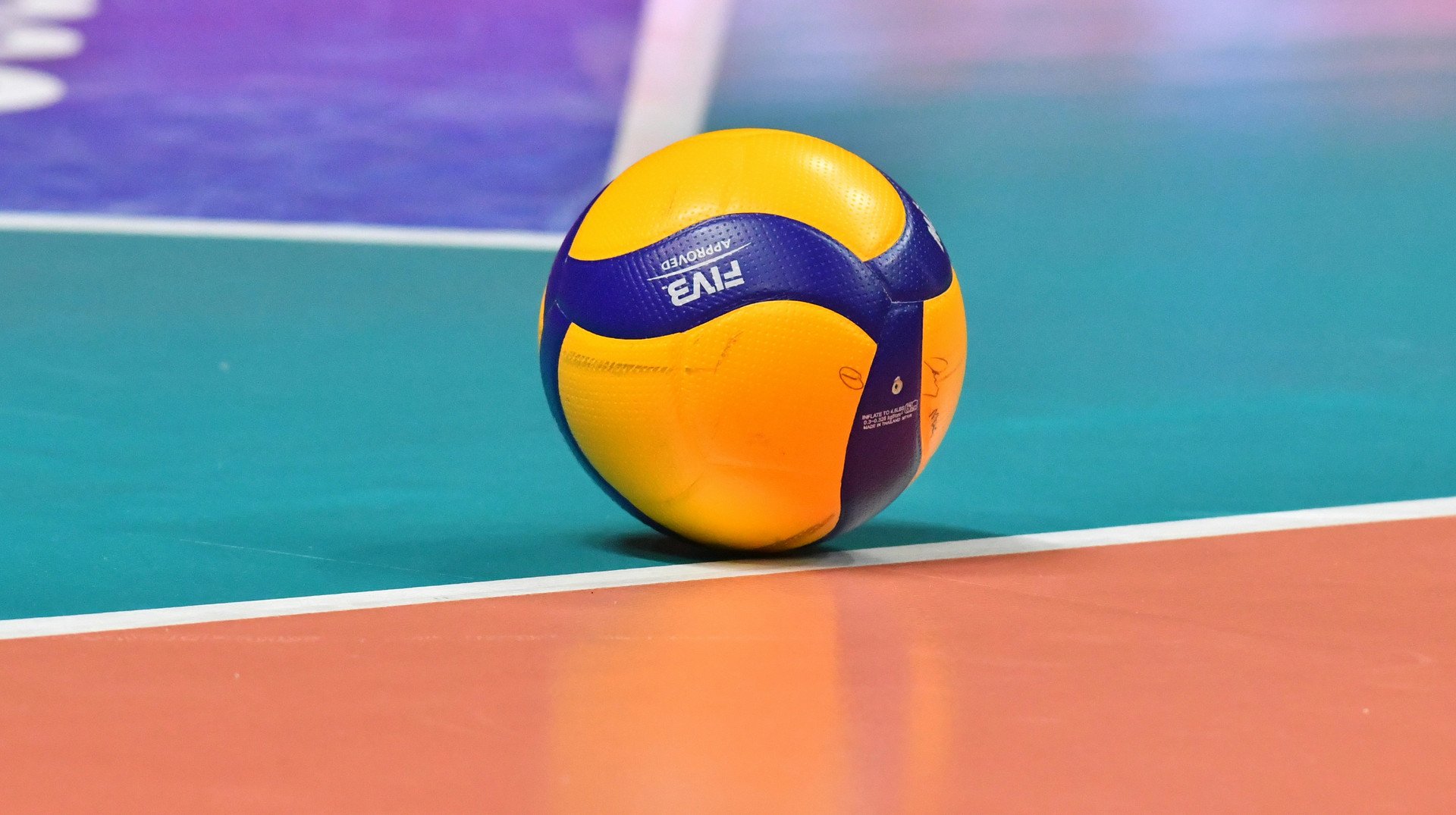“
It is clear that against the background of success in volleyball players, much attention is drawn to the fans. However, not all of them know the basic rules of this dynamic and exciting sport.
This material is intended to acquaint readers with the basics of volleyball game, namely: history, basic rules, competitions held in Europe and the world.
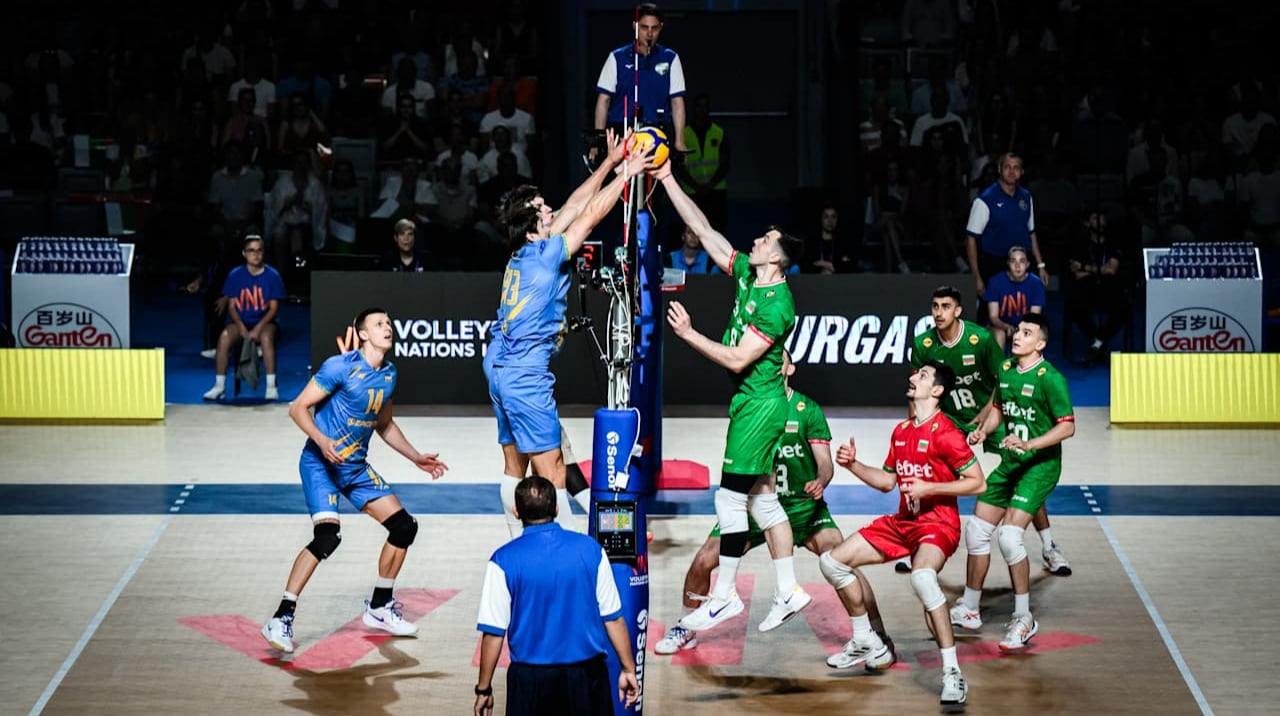
Historical excursion William J. Morgan, a teacher of physical education of the College of the Association of Young Christians in Kholyok in Masachusetts, USA, is considered inventor of volleyball. In 1895, in the gym, he hung a tennis grid at a height of 198 cm, and his students began to throw a basketball ball through it.
Now you can only sympathize with young students because of their fingertips after a few hours of play, but a new sport has become popular quickly. In 1897, the first volleyball rules were published in the United States.
The game developed and spread very quickly, and in the period 1915-1925, most of the rules that still apply. Although nowadays, certain nuances of volleyball continue to change.
Playing field Includes a playground and a free area. The playground is a rectangle 18×9 meters in size, surrounded on all sides by a free zone at least 3 m wide.
A free game space is a space above the game field. Its minimum height is 7 m from the game surface.
For world competitions, the free area should be at least 5 m from the side lines and 6.5 m from the front. The free game space should be at least 12.5 m in height.
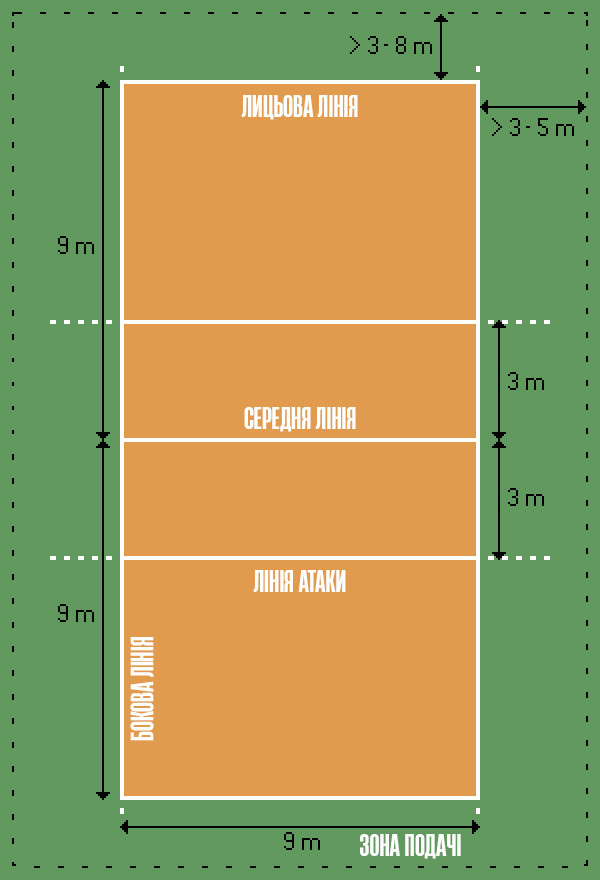 The size of the volleyball court
The size of the volleyball courtThe playing field is made of homogeneous solid material. It is usually a synthetic coating. It is strictly forbidden to play on uneven or slippery surfaces to avoid injury.
Exactly in the middle of the field passes the middle line above which the volleyball grid is stretched. In men’s tournaments, its height is 2.43 m, in women’s – 2.24 m. The racks on which the grid is hung, located at a distance of one meter from the side lines.
The antenna is a flexible rod of 1.8 m long and 10 mm in diameter, made of fiberglass or similar material. Two antennas are attached from the outer edge of the restrictive tapes and are located on opposite sides of the grid. The antennas outline the boundaries of the game zone. The ball should fly over the net strictly in the space between them.
Each volleyball team is on its own half, which has a 9 × 9 m square.
Attack lines on each half of the gaming field (on volleyball slang, they are usually called three -meter lines) limit the front zone. They are applied at a distance of 3 m from the central line.
Volleyball ball The volleyball ball should be spherical, 65-67 centimeters, weighing 260-280 grams and made of composite leather. For a long time, white balls were used in official competitions. Nowadays, the best color scheme of the ball is recognized white and yellow-blue, so they now play in official competitions.
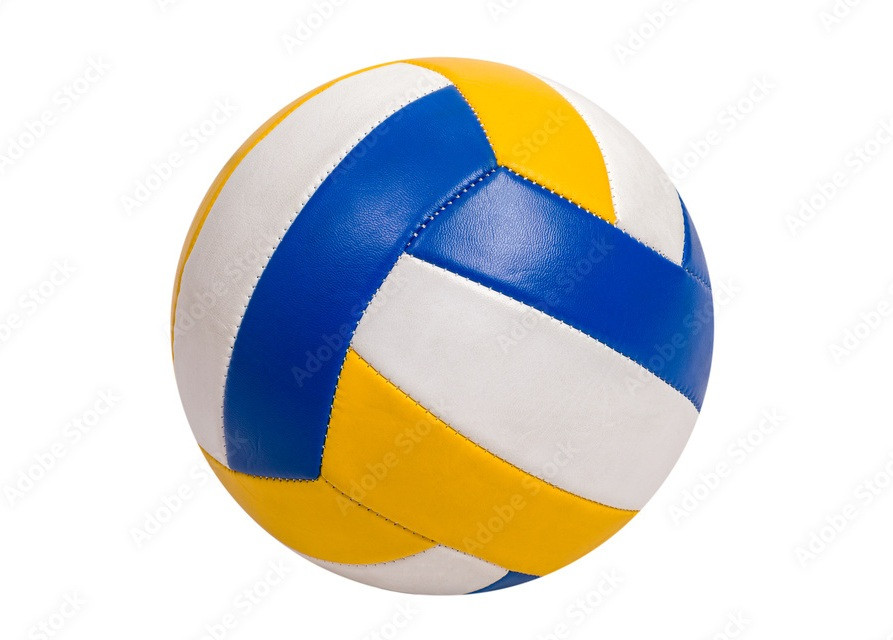 Volleyball ball
Volleyball ballThe purpose of the game The main purpose of the game in volleyball is by any authorized rules to blow the ball through the net so that it touches the opponent’s playground. The point can also be earned if the opponent has not thrown the ball back through the grid for three touches or did so in violation of the rules.
Players cannot touch the ball twice (the block is not considered to touch). Typically, the team tries to organize the attack with three touch (more forbidden, less – it is possible, but in modern volleyball such options are infrequently used): the first – receiving the opponent with bringing the ball to the binding, the second – the transfer to the attacker player, the third – the impact.
You need to score 25 points to win the team. If the score 24:24, the set will continue until one of the teams will be advised to gain an advantage of two points. Interesting fact. The longest volleyball party has been played in the match South Korean Men’s League. The meeting of the Korean Eyr Jambos teams and Rash and Kesh Vespid ended with a score of 3-0 (25:22, 25:23, 56:54).
To win the match you need to win in three parties. If the meeting goes to the fifth set (account for parties 2: 2), then it lasts up to 15 points with the same prerequisite: the advantage of one of the teams at least two points. There is no draw in volleyball.
Zones and transitions to the playground The volleyball site on each side is conditionally divided into six zones: three under the grid (front line) and three behind, three meters from the grid (rear line). Three front line players occupy positions (left to right) 4, 3 and 2, and the rear line players, respectively, 5, 6 and 1 (the position of the submission). This order is stored throughout the party. Before each set, the coach represents the main arbitrator of the initial location of his team in a special placement card.
At the time of struck on the ball at the time of submission, the players of both teams must be located within their area in order of transition, except for who submits. If the team wins the point when other people’s feed, the players, moving clockwise, go to other zones (3 – in 2, 2 – in 1, 1 – B 6).
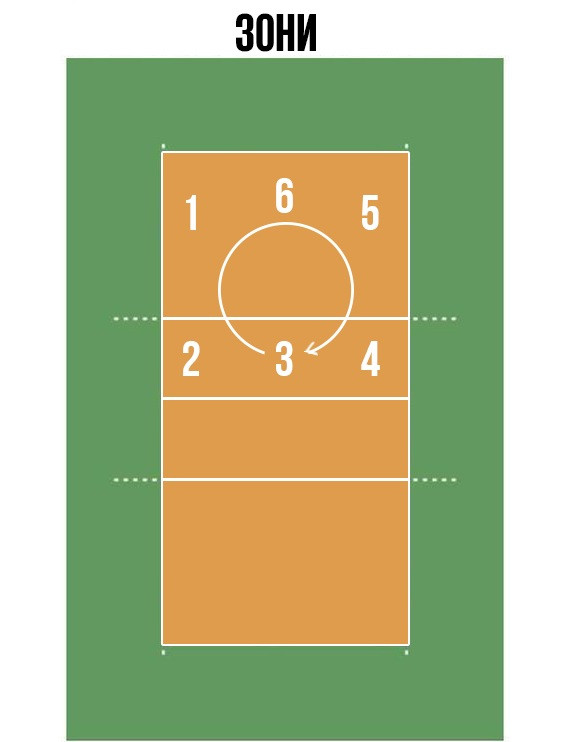 Numbering zones at the volleyball court
Numbering zones at the volleyball courtBasic Volleyball Rules
- Two teams play, each consists of 6 people (3 – attack line, 3 – protection line)
- It is forbidden to catch, throw or hold the ball
- The rear line players are forbidden to attack the attack zone. If the rear line volleyball players want to perform an attacking blow, they should make a jump to a 3-meter line without getting over for it
- In the process of drawing you cannot touch the grid and antennas
- Contact the ball with any part of the player’s body (yes, the leg in volleyball can be played!)
- If two or more players touch the ball at the same time – this is considered one touch
- On the feed is given 8 seconds from the moment of the Judge’s whistle
- In each party, the team can make a maximum of 6 substitutions (this rule is not libero). At the same time, you can replace several performers. The player who has been replaced can only return to the game to the position of the volleyball player who came out instead. This can be done once in the party.
- Each team in one party has the right to take 2 Taimuta lasting 30 seconds
- The ball draw begins with its feed through the grid. The first submission in the first and decisive parties is performed by a team that has chosen the right to serve. The rest of the parties are the first to provide a team that did not do it first in the previous party.
- The supply is carried out from the area of feed on the front line by a blow on the ball with a brush of the hand after the ball has been thrown or released from the hands. When serving in a jump of repulsion from the floor The Herchi should take place to the front line. Landing is allowed within the game zone
- The players of the host team, grazing the ball to each other, try to send it back to the side of the serving team, for a maximum of three beats. Both intentional and unintentional collisions of players with the ball are implied. The game projectile can touch the grid during the transition through it.
The players’ role in the team Each team can declare a maximum of 14 players. As already noted, there are 6 volleyball players at the same time. They have the following role:
Binding. This is the brain of the team. His task – give a convenient transfer to an attacking player after taking a ball with a teammate. Ideally, the ball should be second to the 3rd zone during the draw. When the arrangement is on the front line, during the attack of the opponent helps on the block. Does not participate in the reception.
Diagonal. Specializes in blocking and attack from 2 and 4 zones. In reception, participation does not take, when she is on the back line often attacks from 1 zone.
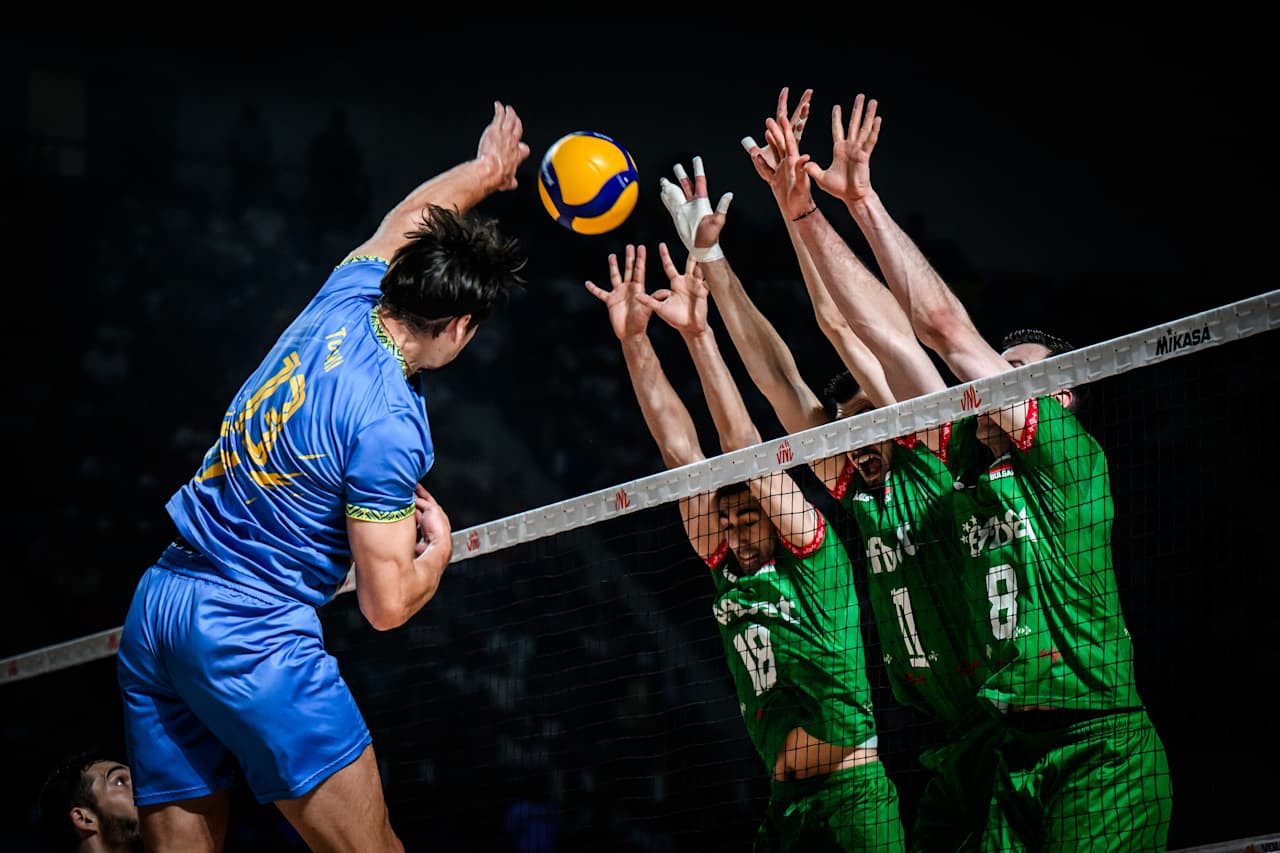 Diagonal national team of Ukraine Vasyl Tupchy attacks against the triple block
Diagonal national team of Ukraine Vasyl Tupchy attacks against the triple block
FIVB
Central blocking. Another player who is not involved in reception. The volleyball player of such a role is concentrated on the attack by the first pace and on the block. Central blocking is usually the highest and most tight team players. There are usually two in the starting lineup.
The harvesting room. A universal player who is directly involved in attack, protection and reception. He must be able to do everything on the site. The start usually comes out two ways.
Libero. It is on the site exclusively on the back line. It is concentrated on the game in defense and reception. Libero does not take the active participation of Libero, and does not perform the feed. Its main task is to try to bring the ball as convenient as possible to the binding. The player of this role is always the specific color of the shape that highlights it among the entire team.
Libero can replace any player on the back line. It usually goes to the site instead of the central locking after it is finished. This is due to the fact that due to anthropometry from the central blocking, little benefit when playing in protection. Only the player whom he had previously changed instead of libero to the playground.
Now let’s look at the types of actions with the ball.
Innings In general, there are as many as 6 types of supply in volleyball, but we will distinguish two. After all, even in amateur volleyball, few people submit from the bottom or side, not to mention professionals.
Power – powerful introduction of the ball into the game in order to create the difficulty of the opponent’s team at the reception. In male volleyball, the ball speed exceeds 110 km/h (record speed – 132 km/h). In terms of technique, such a feed is quite complicated. When fulfilled, the probability of making a mistake, namely not to direct the ball for half the platform of the opponent, is quite high
Planning (glider) – The element is quite difficult to perform: in the process of flight, the ball is unforeseen changing the trajectory. It can catch the opponent by surprise or noticeably complicate the reception
Attacking Discount – a special technical move that allows you to catch the opponent by surprise or to knock it from the rhythm. Usually it is a slight but accurate direction of the ball into an unprotected opponent zone
Direct attack – Attack is performed by a central blocking or a fever from a small run and a high jump, the impact is performed in the course of the volleyball player’s body
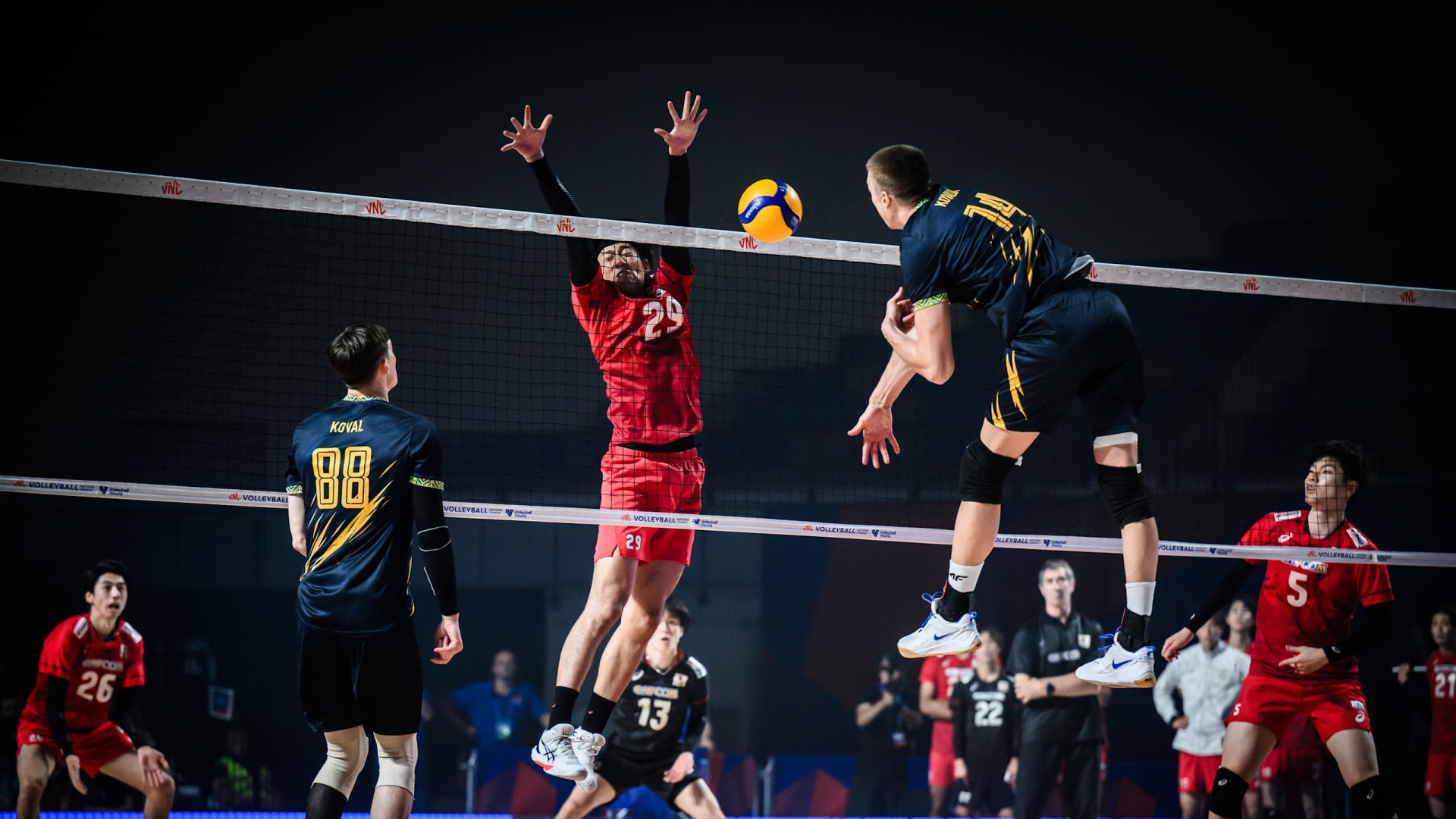 In the attack Ilya Kovalev
In the attack Ilya Kovalev
FIVB
The lateral attack – performed with a straightened hand with a high jump. The ball with such impact is directed to the opponent’s zone to the side of the grid
Locking Only players in the front line can block the ball. Blocking in volleyball is the removal of any part of the body above the upper edge of the grid in order not to give the ball when the opponent is attacked. If the ball was affected by one of the players who participated in the block, then the block is considered to have happened.
The number of people involved in this element of the game is single. double and triple.
In the space of the opponent, the lock is allowed. You can move your hand to the side of the opponent, but it should not interfere with the game. It is forbidden to block the opponent’s supply, as well as the transmission that occurs on the side of the opponents.
Pass There are two types of belts in volleyball: upper and lower.
The upper pass – Reception, in which the ball is accepted and transmitted by the palms and fingers of two hands above the head. It is forbidden to hold the ball in your hands
The lower pass – The ball is treated from below with two hands. It is performed in cases where the ball flies low. Touching to the ball is an area of hands between wrists and elbows.
During the text, mistakes were mentioned during the game, which were punished by awarding opponents. We systematize them.
Mistakes in volleyball
- Touching the ball with one player twice in one draw (block, we remind you that it is not included, but a double touch is considered to overcome the ball in the hands during the upper gear)
- Trying for the front line during the submission or three -meter line during the attack by the player, which is in place during the draw in the defense zone (1, 5, or 6)
- Trying for the midline of the field (it is fixed if the hand and/or the player’s foot are fully in half of the enemy field)
- More than three touches the team for a draw
- Disruption in placement
- Failure to donate for more than 8 seconds since the referee whistle
- Touch the player with a grid, antenna, or a ball hit in an antenna from the volleyball player of his team.
- Non -sports behavior of volleyball players, conflicts with the judicial brigade
And who is the judge? The Judicial Brigade for the match includes:
Chief Judge. Located on a tower, controls a match and controls the work of a judge’s brigade
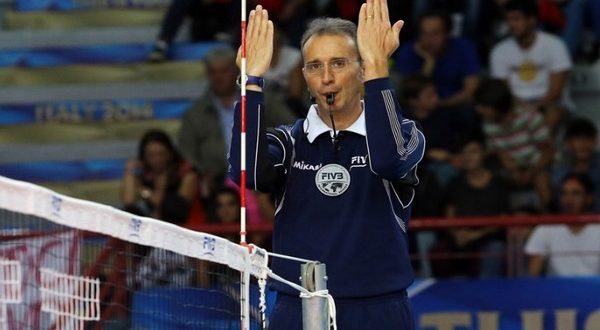 Chief Judge recorded an out
Chief Judge recorded an outThe second judge. His position is on the other side of the net from the main referee, face to him. Helps him in work, controls the correctness of replacement, and also accepts requests from team coaches
Linear judges. They can be two or four, located on the front lines on both sides of the playground and control the hit of the ball within its borders. With the development of linear judges technique, the system of automatic determination of the clump of the ball, similar to the tennis “hawk-eye” is increasingly replaced.
It should be noted that volleyball has a system of yellow and red cards, but it is significantly different from the football.
The non -sports behavior of a player or trainer is punishable by a verbal warning or yellow card. The sanctions are not imposed on the offender.
Rough behavior is punishable by a red card. The feed goes to the opponent’s team and she receives an extra point. Repeated violation is punishable by a red and yellow card at the same time, which leads to the removal of the player. It should be in a place for the seized players. The third violation by one player leads to disqualification: it should leave the site until the match is completed.
In the case of open aggression, the player is punished with disqualification and should immediately leave the playground.
Often used volleyball terms Ace – A term similar to tennis. However, if the tennis is called a precision feed, in which the receiving does not touch the ball, then in volleyball is understood in this term, after which a team of opponents for three touches cannot translate a game projectile through a grid.
Break – In tennis it is a game taken to serve the opponent. In volleyball, on the contrary, the break is the point, obtained on its feed. The logic here is simple: in tennis the advantage has the one who presents, and in volleyball – the one who accepts, because the receiving side the first can attack.
The first tempo – A quick attack in which the attacking beats on the ball after a short transmission of the binder. The impact is usually performed by the central blocker from the third zone, that is, in the center of the grid. Due to the high speed of the attacking side, the first tempo is difficult for rivals to block.
The second tempo – An attack, when the binder gives the second transmission to diagonal attacks or guarantors. The impact in this case is made of 2, 4 or 1 zone. The second pace was named because the ball after the transmission of the binder flies much longer than the first.
Pipe – a spectacular element when the bonding brings out a player from 6 zone. Attacking volleyball player should push away from the gaming surface to a three -meter line
Block-out – Attack after which the ball hit the block and goes out into the out
To play from the block -Technical blow on the edge of the block send the ball from it to the out (make block-out)
Drive under the skin – to strike such an attacking blow, after which the ball falls on the side of the opponents between the hands of the blocking and the grid
To take off from the submission – win a point on the opponent and make a transition
Transitional ball – A ball that flies to the opponent’s side is low above the grid, usually after unsuccessful administration.
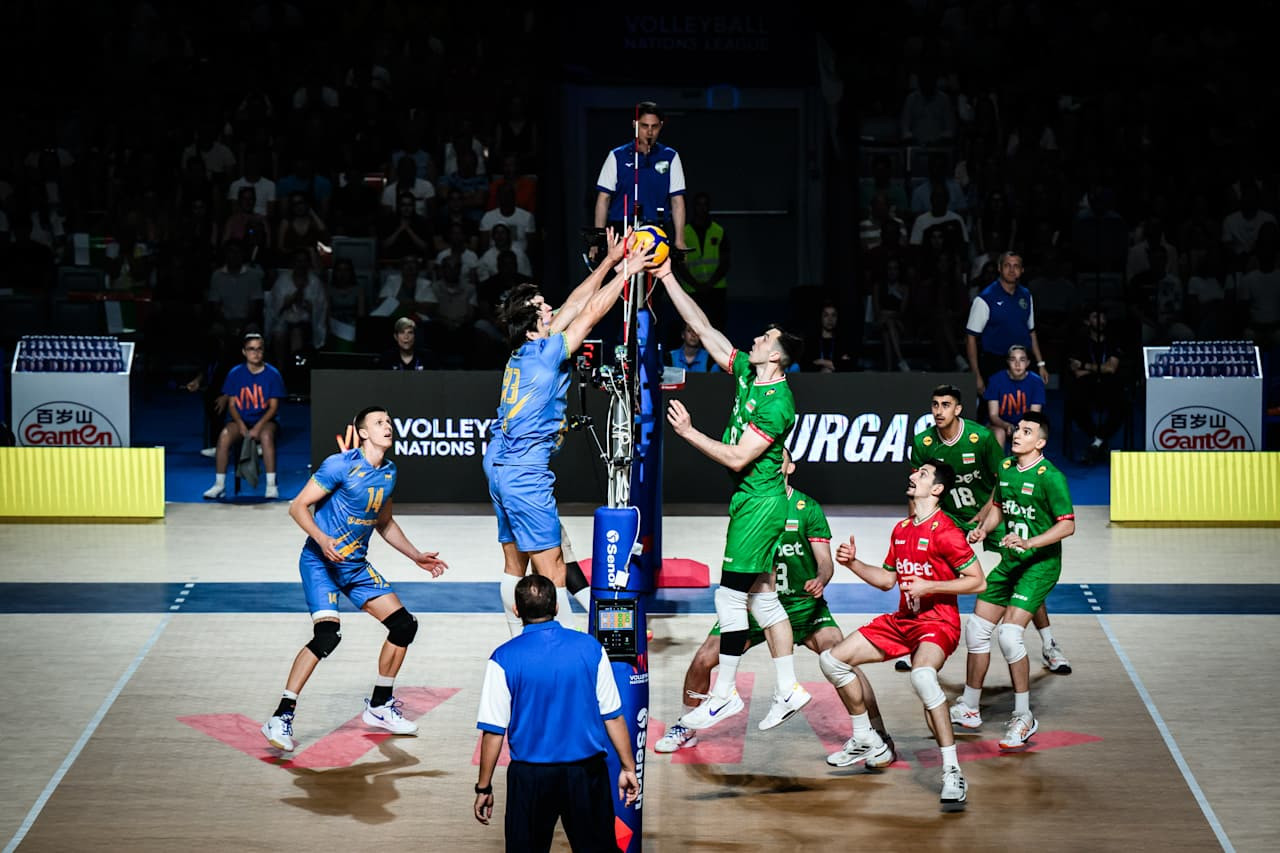 National teams of Ukraine and Bulgaria fight for a transition ball
National teams of Ukraine and Bulgaria fight for a transition ball
FIVB
Another’s ball – A mistake of a player who tries to hit the ball that has not switched to the side of his team (did not become a transitional).
Competition for clubs and national teams As with other team sports, volleyball tournaments are held for national teams and clubs.
The most important competition of national teams is the Olympic Games, which are held every four years. The current Olympic champion in men is the French team, and women have a national team of Italy.
The World Championships until 2022 were also held every four years. However, since 2025, they will play twice as often, in the odd years. In 2025, men will hold a championship in the Philippines, where the title will be protected by the Italians, and women in Thailand, where they will defend their victory with Serbs.
The draws of the League of Nations are held annually. This year, for the first time in history, the men’s national team of Ukraine participates in the tournament and has a chance to get in the eight of the best teams, which will compete for winning the competition.
Even lower rank have continental championships. The national teams of Ukraine of both sexes, of course, appear at the European Championships.
Club European teams find stronger in national championships and – the strongest – in the European Cups. Both men and women compete in the following Euro tournaments, in terms of prestige: Champions League, EKV Cup, EKV Cup.
It should be noted that the League of Champions of the 2024-25 season was won by the Italian “Perudzha”, and its Ukrainian hallmark Oleg Plotnitsky got into the symbolic national team of the four hall. Unfortunately, Plotnitsky ended his career in the national team of Ukraine because of a conflict with the National Federation.
”, – WRITE: Champion.com.ua
It is clear that against the background of success in volleyball players, much attention is drawn to the fans. However, not all of them know the basic rules of this dynamic and exciting sport.
This material is intended to acquaint readers with the basics of volleyball game, namely: history, basic rules, competitions held in Europe and the world.

Historical excursion William J. Morgan, a teacher of physical education of the College of the Association of Young Christians in Kholyok in Masachusetts, USA, is considered inventor of volleyball. In 1895, in the gym, he hung a tennis grid at a height of 198 cm, and his students began to throw a basketball ball through it.
Now you can only sympathize with young students because of their fingertips after a few hours of play, but a new sport has become popular quickly. In 1897, the first volleyball rules were published in the United States.
The game developed and spread very quickly, and in the period 1915-1925, most of the rules that still apply. Although nowadays, certain nuances of volleyball continue to change.
Playing field Includes a playground and a free area. The playground is a rectangle 18×9 meters in size, surrounded on all sides by a free zone at least 3 m wide.
A free game space is a space above the game field. Its minimum height is 7 m from the game surface.
For world competitions, the free area should be at least 5 m from the side lines and 6.5 m from the front. The free game space should be at least 12.5 m in height.
 The size of the volleyball court
The size of the volleyball courtThe playing field is made of homogeneous solid material. It is usually a synthetic coating. It is strictly forbidden to play on uneven or slippery surfaces to avoid injury.
Exactly in the middle of the field passes the middle line above which the volleyball grid is stretched. In men’s tournaments, its height is 2.43 m, in women’s – 2.24 m. The racks on which the grid is hung, located at a distance of one meter from the side lines.
The antenna is a flexible rod of 1.8 m long and 10 mm in diameter, made of fiberglass or similar material. Two antennas are attached from the outer edge of the restrictive tapes and are located on opposite sides of the grid. The antennas outline the boundaries of the game zone. The ball should fly over the net strictly in the space between them.
Each volleyball team is on its own half, which has a 9 × 9 m square.
Attack lines on each half of the gaming field (on volleyball slang they are usually called three -meter lines) limit the front zone. They are applied at a distance of 3 m from the central line.
Volleyball ball The volleyball ball should be spherical, 65-67 centimeters, weighing 260-280 grams and made of composite leather. For a long time, white balls were used in official competitions. Nowadays, the best color scheme of the ball is recognized white and yellow-blue, so they now play in official competitions.
 Volleyball ball
Volleyball ballThe purpose of the game The main purpose of the game in volleyball is by any authorized rules to blow the ball through the net so that it touches the opponent’s playground. The point can also be earned if the opponent has not thrown the ball back through the grid for three touches or did so in violation of the rules.
Players cannot touch the ball twice (the block is not considered to touch). Typically, the team tries to organize the attack with three touch (more forbidden, less – it is possible, but in modern volleyball such options are infrequently used): the first – receiving the opponent with bringing the ball to the binding, the second – the transfer to the attacker player, the third – the impact.
You need to score 25 points to win the team. If the score 24:24, the set will continue until one of the teams will be advised to gain an advantage of two points. Interesting fact. The longest volleyball party has been played in the match South Korean Men’s League. The meeting of the Korean Eyr Jambos teams and Rash and Kesh Vespid ended with a score of 3-0 (25:22, 25:23, 56:54).
To win the match you need to win in three parties. If the meeting goes to the fifth set (account for parties 2: 2), then it lasts up to 15 points with the same prerequisite: the advantage of one of the teams at least two points. There is no draw in volleyball.
Zones and transitions to the playground The volleyball site on each side is conditionally divided into six zones: three under the grid (front line) and three behind, three meters from the grid (rear line). Three front line players occupy positions (left to right) 4, 3 and 2, and the rear line players, respectively, 5, 6 and 1 (the position of the submission). This order is stored throughout the party. Before each set, the coach represents the main arbitrator of the initial location of his team in a special placement card.
At the time of struck on the ball at the time of submission, the players of both teams must be located within their area in order of transition, except for who submits. If the team wins the point when other people’s feed, the players, moving clockwise, go to other zones (3 – in 2, 2 – in 1, 1 – B 6).
 Numbering zones at the volleyball court
Numbering zones at the volleyball courtBasic Volleyball Rules
- Two teams play, each consists of 6 people (3 – attack line, 3 – protection line)
- It is forbidden to catch, throw or hold the ball
- The rear line players are forbidden to attack the attack zone. If the rear line volleyball players want to perform an attacking blow, they should make a jump to a 3-meter line without getting over for it
- In the process of drawing you cannot touch the grid and antennas
- Contact the ball with any part of the player’s body (yes, the leg in volleyball can be played!)
- If two or more players touch the ball at the same time – this is considered one touch
- On the feed is given 8 seconds from the moment of the Judge’s whistle
- In each party, the team can make a maximum of 6 substitutions (this rule is not libero). At the same time, you can replace several performers. The player who has been replaced can only return to the game to the position of the volleyball player who came out instead. This can be done once in the party.
- Each team in one party has the right to take 2 Taimuta lasting 30 seconds
- The ball draw begins with its feed through the grid. The first submission in the first and decisive parties is performed by a team that has chosen the right to serve. The rest of the parties are the first to provide a team that did not do it first in the previous party.
- The supply is carried out from the area of feed on the front line by a blow on the ball with a brush of the hand after the ball has been thrown or released from the hands. When leaping away from the surface, it should take place to the front line. Landing is allowed within the game zone
- The players of the host team, grazing the ball to each other, try to send it back to the side of the serving team, for a maximum of three beats. Both intentional and unintentional collisions of players with the ball are implied. The game projectile can touch the grid during the transition through it.
The players’ role in the team Each team can declare a maximum of 14 players. As already noted, there are 6 volleyball players at the same time. They have the following role:
Binding. This is the brain of the team. His task – give a convenient transfer to an attacking player after taking a ball with a teammate. Ideally, the ball should be second to the 3rd zone during the draw. When the arrangement is on the front line, during the attack of the opponent helps on the block. Does not participate in the reception.
Diagonal. Specializes in blocking and attack from 2 and 4 zones. In reception, participation does not take, when she is on the back line often attacks from 1 zone.
 Diagonal national team of Ukraine Vasyl Tupchy attacks against the triple block
Diagonal national team of Ukraine Vasyl Tupchy attacks against the triple block
FIVB
Central blocking. Another player who is not involved in reception. The volleyball player of such a role is concentrated on the attack by the first pace and on the block. Central blocking is usually the highest and most tight team players. There are usually two in the starting lineup.
The harvesting room. A universal player who is directly involved in attack, protection and reception. He must be able to do everything on the site. The start usually comes out two ways.
Libero. It is on the site exclusively on the back line. It is concentrated on the game in defense and reception. Libero does not take the active participation of Libero, and does not perform the feed. Its main task is to try to bring the ball as convenient as possible to the binding. The player of this role is always the specific color of the shape that highlights it among the entire team.
Libero can replace any player on the back line. It usually goes to the site instead of the central locking after it is finished. This is due to the fact that due to anthropometry from the central blocking, little benefit when playing in protection. Only the player whom he had previously changed instead of libero to the playground.
Now let’s look at the types of actions with the ball.
Innings In general, there are as many as 6 types of supply in volleyball, but we will distinguish two. After all, even in amateur volleyball, few people submit from the bottom or side, not to mention professionals.
Power – a powerful ball introduction to the game in order to create difficulty team of opponent on Reception. In male volleyball, the ball speed exceeds 110 km/h (record speed – 132 km/h). In terms of technique, such a feed is quite complicated. When fulfilled, the probability of making a mistake, namely not to direct the ball for half the platform of the opponent, is quite high
Planning (glider) – The element is quite difficult to perform: in the process of flight, the ball is unforeseen changing the trajectory. It can catch the opponent by surprise or noticeably complicate the reception
Attacking Discount – a special technical move that allows you to catch the opponent by surprise or to knock it from the rhythm. Usually it is a slight but accurate direction of the ball into an unprotected opponent zone
Direct attack – Attack is performed by a central blocking or a fever from a small run and a high jump, the impact is performed in the course of the volleyball player’s body
 In the attack Ilya Kovalev
In the attack Ilya Kovalev
FIVB
The lateral attack – performed with a straightened hand with a high jump. The ball with such impact is directed to the opponent’s zone to the side of the grid
Locking Only players in the front line can block the ball. Blocking in volleyball is the removal of any part of the body above the upper edge of the grid in order not to give the ball when the opponent is attacked. If the ball was affected by one of the players who participated in the block, then the block is considered to have happened.
The number of people involved in this element of the game is single. double and triple.
In the space of the opponent, the lock is allowed. You can move your hand to the side of the opponent, but it should not interfere with the game. It is forbidden to block the opponent’s supply, as well as the transmission that occurs on the side of the opponents.
Pass There are two types of belts in volleyball: upper and lower.
The upper pass – Reception, in which the ball is accepted and transmitted by the palms and fingers of two hands above the head. It is forbidden to hold the ball in your hands
The lower pass – The ball is treated from below with two hands. It is performed in cases where the ball flies low. Touching to the ball is an area of hands between wrists and elbows.
During the text, mistakes were mentioned during the game, which were punished by awarding opponents. We systematize them.
Mistakes in volleyball
- Touching the ball with one player twice in one draw (block, we remind you that it is not included, but a double touch is considered to overcome the ball in the hands during the upper gear)
- Trying for the front line during the submission or three -meter line during the attack by the player, which is in place during the draw in the defense zone (1, 5, or 6)
- Trying for the midline of the field (it is fixed if the hand and/or the player’s foot are fully in half of the enemy field)
- More than three touches the team for a draw
- Disruption in placement
- Failure to donate for more than 8 seconds since the referee whistle
- Touch the player with a grid, antenna, or a ball hit in an antenna from the volleyball player of his team.
- Non -sports behavior of volleyball players, conflicts with the judicial brigade
And who is the judge? The Judicial Brigade for the match includes:
Chief Judge. Located on a tower, controls a match and controls the work of a judge’s brigade
 Chief Judge recorded an out
Chief Judge recorded an outThe second judge. His position is on the other side of the net from the main referee, face to him. Helps him in work, controls the correctness of replacement, and also accepts requests from team coaches
Linear judges. They can be two or four, located on the front lines on both sides of the playground and control the hit of the ball within its borders. With the development of linear judges technique, the system of automatic determination of the clump of the ball, similar to the tennis “hawk-eye” is increasingly replaced.
It should be noted that volleyball has a system of yellow and red cards, but it is significantly different from the football.
The non -sports behavior of a player or trainer is punishable by a verbal warning or yellow card. The sanctions are not imposed on the offender.
Rough behavior is punishable by a red card. The feed goes to the opponent’s team and she receives an extra point. Repeated violation is punishable by a red and yellow card at the same time, which leads to the removal of the player. It should be in a place for the seized players. The third violation by one player leads to disqualification: it should leave the site until the match is completed.
In the case of open aggression, the player is punished with disqualification and should immediately leave the playground.
Often used volleyball terms Ace – A term similar to tennis. However, if the tennis is called a precision feed, in which the receiving does not touch the ball, then in volleyball is understood in this term, after which a team of opponents for three touches cannot translate a game projectile through a grid.
Break – In tennis it is a game taken to serve the opponent. In volleyball, on the contrary, the break is the point, obtained on its feed. The logic here is simple: in tennis the advantage has the one who presents, and in volleyball – the one who accepts, because the receiving side the first can attack.
The first tempo – A quick attack in which the attacking beats on the ball after a short transmission of the binder. The impact is usually performed by the central blocker from the third zone, that is, in the center of the grid. Due to the high speed of the attacking side, the first tempo is difficult for rivals to block.
The second tempo – An attack, when the binder gives the second transmission to diagonal attacks or guarantors. The impact in this case is made of 2, 4 or 1 zone. The second pace was named because the ball after the transmission of the binder flies much longer than the first.
Pipe – a spectacular element when the bonding brings out a player from 6 zone. Attacking volleyball player should push away from the gaming surface to a three -meter line
Block-out – Attack after which the ball hit the block and goes out into the out
To play from the block -Technical blow on the edge of the block send the ball from it to the out (make block-out)
Drive under the skin – to strike such an attacking blow, after which the ball falls on the side of the opponents between the hands of the blocking and the grid
To take off from the submission – win a point on the opponent and make a transition
Transitional ball – A ball that flies to the opponent’s side is low above the grid, usually after unsuccessful administration.
 National teams of Ukraine and Bulgaria fight for a transition ball
National teams of Ukraine and Bulgaria fight for a transition ball
FIVB
Another’s ball – A mistake of a player who tries to hit the ball that has not switched to the side of his team (did not become a transitional).
Competition for clubs and national teams As with other teams Sports, volleyball tournaments for their countries and clubs are held in volleyball.
The most important competition of national teams is the Olympic Games, which are held every four years. The current Olympic champion in men is the French team, and women have a national team of Italy.
The World Championships until 2022 were also held every four years. However, since 2025, they will play twice as often, in the odd years. In 2025, men will hold a championship in the Philippines, where the title will be protected by the Italians, and women in Thailand, where they will defend their victory with Serbs.
The draws of the League of Nations are held annually. This year, for the first time in history, the men’s national team of Ukraine participates in the tournament and has a chance to get in the eight of the best teams, which will compete for winning the competition.
Even lower rank have continental championships. The national teams of Ukraine of both sexes, of course, appear at the European Championships.
Club European teams find stronger in national championships and – the strongest – in the European Cups. Both men and women compete in the following Euro tournaments, in terms of prestige: Champions League, EKV Cup, EKV Cup.
It should be noted that the League of Champions of the 2024-25 season was won by the Italian “Perudzha”, and its Ukrainian hallmark Oleg Plotnitsky got into the symbolic national team of the four hall. Unfortunately, Plotnitsky ended his career in the national team of Ukraine because of a conflict with the National Federation.
